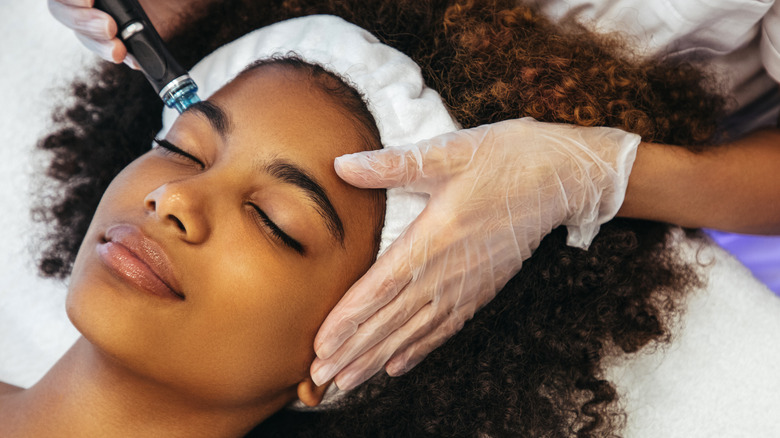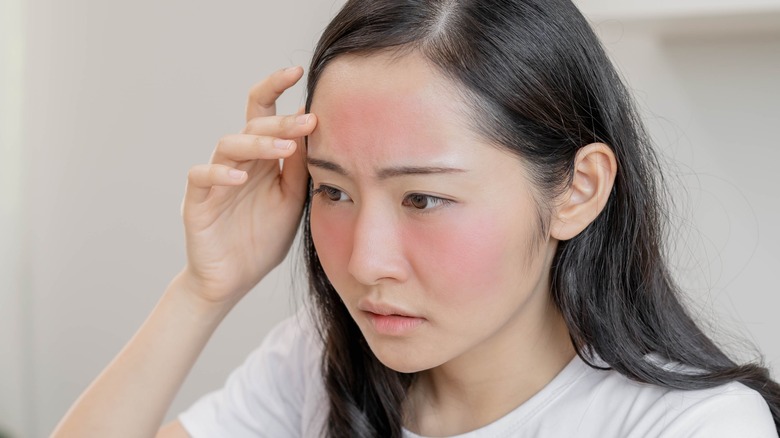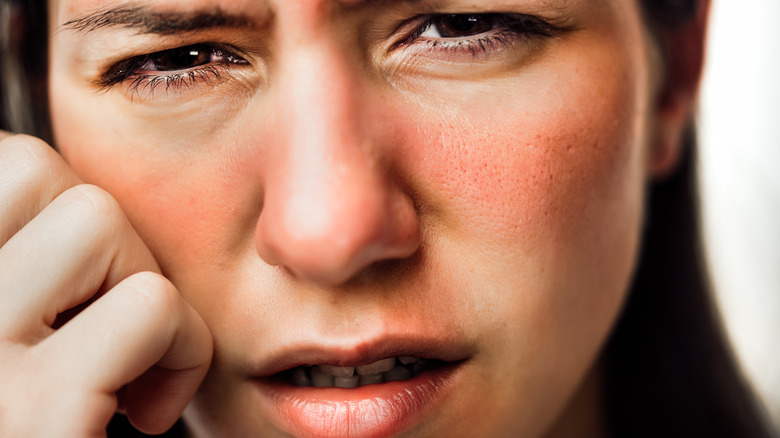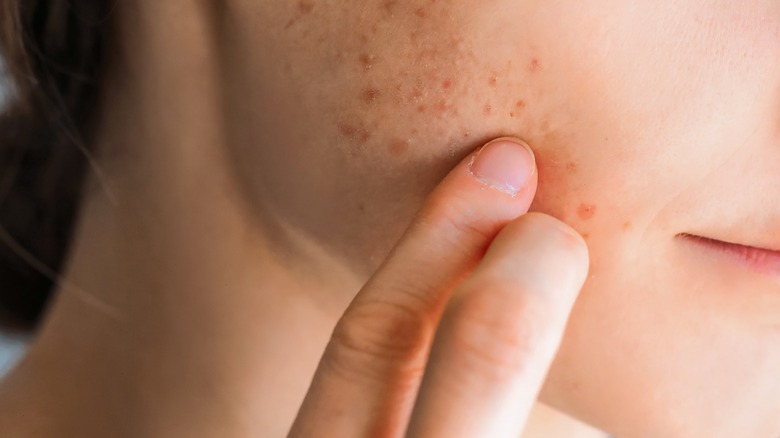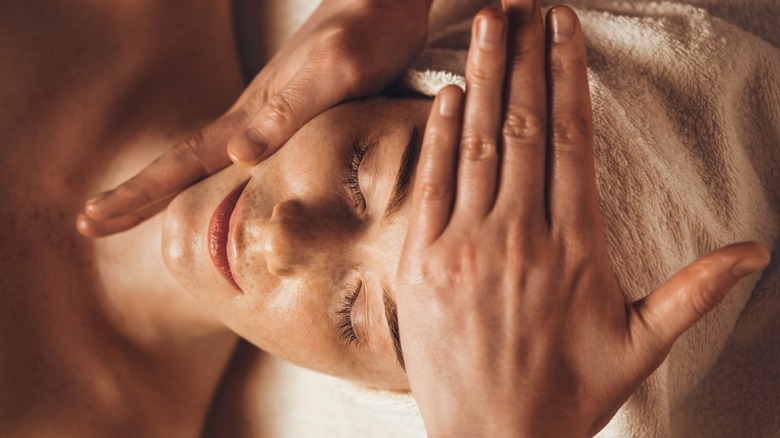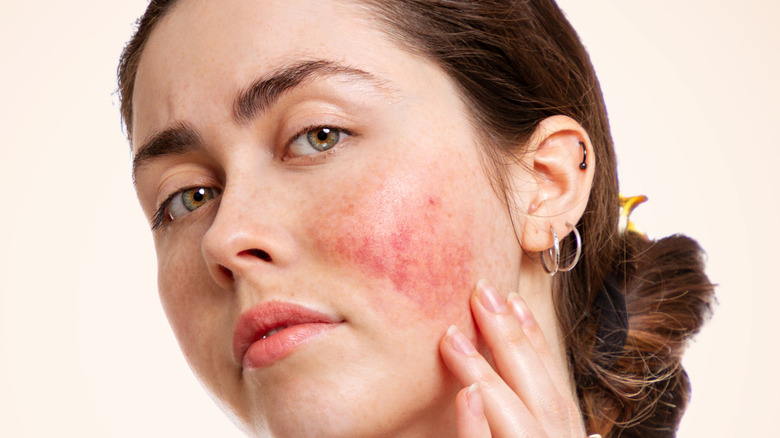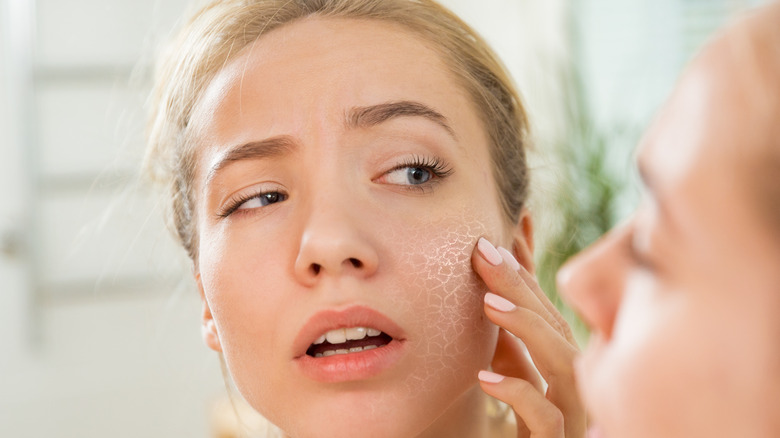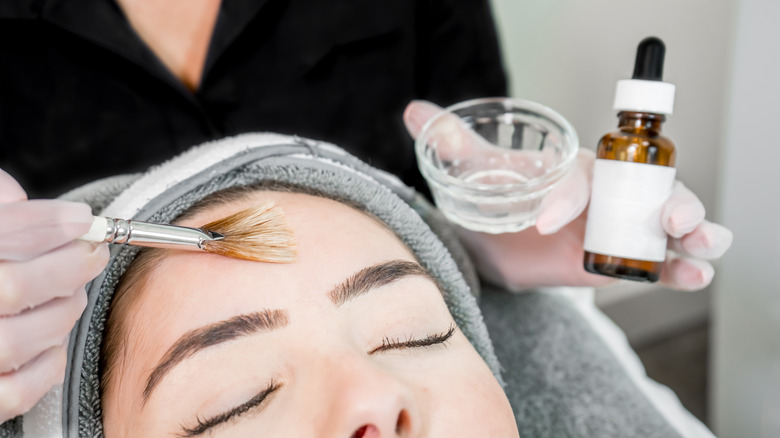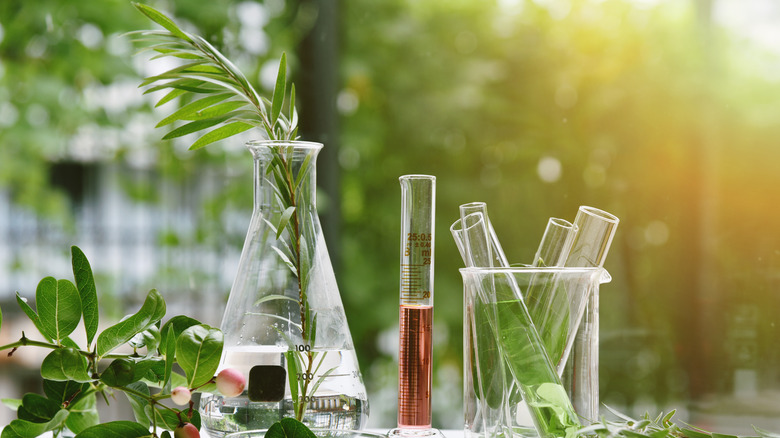10 Red Flags Your Facial Isn't Turning Out How It Should
You've finally decided to take control of your skin. You've done the research, found your doctor, underwent some tests, and now you're ready to wade into the deeper waters of skincare. One of the things everyone raves about is facials, and you're constantly hearing all the benefits of getting one yourself. Perhaps you're unsure about what to expect when getting a facial and are still on the fence about whether it will turn out well or if it's even going to be worth the more-than-likely steep price tag.
Usually, facials turn out relatively well, and you don't have anything to be worried about. But if you've got especially sensitive or problem-laden skin, you probably want a little bit more reassurance than just that. Facials can be intimidating and expensive, so it's important to be prepared for the before — and after — of your treatment. Deep chemical peels are a once-in-a-lifetime experience, but medium-level chemical treatments can be done every few months and gentle treatments every few weeks.
So whether you're doing your facials to fix your skin or doing them just to improve a few things here and there, you're going to be expecting certain results at the end of the process — and you certainly don't want to be leaving the salon with more problems that you came in with. Let us help. We'll run you through what you don't want to see happening after your facial as well as what you don't want from your facialist while you're in the salon. Here are 10 red flags your facial isn't turning out how it should.
You shouldn't have excessive inflammation
Some post-treatment redness is normal for almost all kinds of facials. If your treatment includes services such as cleaning out pores or blackheads, a massage, or an acid peel, then you're going to be getting some redness showing at least the day of your procedure and possibly even up to 48 hours after. Manual extractions, especially, are prone to inflammation afterward.
Renée Rouleau, a celebrity esthetician, tells Marie Claire, "... the reality is, an esthetician is actually squeezing at the skin, so it's normal for the area to get red — especially if the clogged pores or blackheads are large and deep and impacted in the skin." An esthetician should be good enough to recognize the signs of when post-treatment redness is possible and let their client know. And even though some inflammation is normal for a short while, it definitely isn't normal for longer than that.
Excessive redness can be a sign of a few things gone awry — and sometimes, it doesn't even have to do with the facial process itself. Redness can be a sign of allergic reactions to certain ingredients or chemicals that were used in the facial (which you might not even be aware of your allergy to at the time of the procedure). Or it can be that the esthetician applied a chemical peel to a blemish which then aggravated the area and caused more redness than usual. Talk to your esthetician about sensitive skin beforehand, and see a dermatologist if your redness or inflammation persists for more than a few days.
You shouldn't feel heat or burning
Just as much as prolonged inflammation is not normal after a facial, neither is feeling like your skin is on fire or even hotter than usual. "There are such a range of facials available that I think that that there is an appropriate facial for almost any skin type," Dr. Sejal Shah of Smarter Skin Dermatology tells SELF. Therefore, if you've got sensitive skin or certain conditions such as psoriasis, getting the incorrect facial will likely lead to inflammation and a leftover burning feeling. So, it's important to communicate any skin concerns with your esthetician.
While some heat is expected after some facials, especially from chemical peels or micro-needling, excessive heat or burning after your facial treatment might mean that the chemical peel wasn't "properly neutralized" or that your skin was allergic to a certain chemical or ingredient used, explains Cindy Kim, cofounder of New York's Silver Mirror Facial Bar, to NewBeauty.
A burning sensation could also be attributed to a non-allergic but still irritating reaction to certain plants or plant derivatives used in your facial. Lastly, your prolonged burning reaction or heat release could also be due to the fact that you exposed your skin to the sun right after your facial, which irritates now-sensitized skin. If you do that daily after your facial, you could inadvertently extend the recovery time from your facial.
You shouldn't be breaking out more
Usually, we go in for a facial treatment to prep the skin for a special event when we want to look our best. Unfortunately, one of the most common side effects of facials is that your skin will break out after — some facialists call this the "purging" of your skin. But it is not something that should be happening excessively — at least not for an extended period.
If your skin is not overly sensitive, you might notice some purging within a day or two after your facial, but it should not last for much longer than that. If it does, you can bet on the clean-up process not having been as thorough as it should have been. "If the pore is not completely cleared during extractions, you may notice an acne flare after the facial as the residual contents come to the surface naturally," Dr. Shah tells SELF.
Breaking out can also potentially be a side-effect of too oily products or too thick products having been applied to your face and your skin not being able to breathe through them. In this case, make sure to let your esthetician know that you need a lighter touch on the cream and lotion application and an overall less oily facial. To top it off? Prescription medications could also cause unnecessary irritation to your skin. You should reveal prescriptions such as steroid creams, antibiotics, anti-inflammatory drugs, and acne medications to your facialist so they know what not to add to your skin.
Your technician is being too rough
Here's a big red flag: You feel like your facialist is being too rough on your skin. Facials are to be delicate procedures as the skin on our face is quite sensitive and even more so for those who deal with problems such as acne or eczema. A good esthetician will have already asked you about any concerns you have before your treatment begins and will use a soft touch when applying product, massaging, or even during extractions.
Your facialist needs to be gentle. Each patient should be taken care of with as much softness as possible, only using gentle pressure and movements to complete your treatment, even if that treatment is the extraction of blackheads. So much so, in fact, that respectable practices such as Premier Dermatology note on their website that multiple treatments may be needed if an extraction can't be completed on the first time so as not to stress or damage the skin unnecessarily.
Your esthetician should have the same mentality. If you feel that you're being roughly handled, make sure to voice your concerns — you're the one that's going to be walking out with your skin, after all. A good facialist will listen to your worries and back off of any troublesome areas that your skin might not be ready to deal with at that time.
You shouldn't be bleeding when your facial is over
Don't read this the wrong way now — it is entirely possible to have some bleeding during your facial. Extractions, especially, can cause bleeding during your treatment if you have deep-set ones, but your esthetician should make you aware of this possibility when you come in.
Your esthetician should also be making sure that once your treatment is over that you're not walking out the door with any active bleeds. Dr. Cindy Kim tells NewBeauty, "A good aesthetician will spend enough time bringing your skin down after extractions. If you notice anything unusual, like continuous bleeding, let your aesthetician know as soon as possible and make sure she/he not only takes care of you but tells you exactly what to use at home and how so as not to cause any more bleeding or irritation."
Obviously, she said a good esthetician — and being left with any of the above side effects once your facial is over is a pretty solid indication that where you went just wasn't the right place. Excessive bleeding is possible if your esthetician was a little too rough with the extractions, and too much pressure was put on pores that weren't ready to be cleared yet, causing capillaries to burst. Unfortunately, this can also lead to scarring, which is the opposite effect that we want when we come in for a facial.
You shouldn't develop dry skin
"It is not uncommon for people to develop dry or rough skin after a facial as well," board-certified dermatologist Joshua Zeichner tells SELF. But that doesn't mean that it should be a "normal" occurrence. Most of the time, developing dry skin after a facial will point to one culprit: over-exfoliation or over-drying of your skin with chemical peels.
This usually happens when your skin is already quite sensitive and, thus, will lead to this reaction and a prolonged dryness of your skin (a normal reaction is a mild dryness for a day or two). But those dealing with common skin problems, such as psoriasis, eczema, or rosacea, should steer clear of the "usual" facials and talk to their esthetician or dermatologist about treatments tailored to those conditions.
Hydrating your skin from the outside and inside is also extremely important. "In general, I tend to advise my clients to keep it simple," esthetician and "hydration specialist," Blaire Arvin tells BeautyTap. "It's good to load up on hydrating components internally and externally for one to three days post-facial," Arvin says. Keeping your skin hydrated as it readjusts and heals is a must to discourage it from staying or becoming overly dry after a facial. Aim for the recommended intake of water every day and apply a simple moisturizer to your face daily. Final note: Wait to reintroduce harsher products such as exfoliators and acids until at least a week post-treatment.
Too many chemicals are being combined
You know how sometimes we can get carried away with the options for skincare, and we just want to try everything? Yeah, well, that might be doing you more harm than good — and it absolutely applies to facials as well. Dermatologist and skincare expert Dr. Jeanette Graf tells Insider, "Too much of a good thing — like over-exfoliating your skin with multiple acids and/or mechanical beads — can result in redness, irritation, dryness, and worsened breakouts. With so many skincare choices available, patients often overuse or combine products — which can worsen their skin."
Usually, products or techniques used during a facial are more aggressive than what you can do yourself at home so it's even more important that you don't go overboard and schedule too many appointments at once or too close together. Your esthetician should be warning you of these, but if you haven't built a relationship with them or are new to facials, you should be aware of the dangers of compounding products during a facial treatment.
Biologique Recherche LA Ambassade aesthetician Mary Stofle explains to NewBeauty, "You don't want a facial that's mixing enzymes, vitamin C, salicylic acid, AHAs, BHAs, glycolic acid, retinoids, active masks ... the list goes on. Calm down and use one or two. Respect the skin's barrier — respect the skin in general." You should always be aware of the products that are going to be used on your skin and think about how they will react together.
You don't know the products being used
This goes hand in hand with the previous topic: We can't stress the importance of knowing just what is going to be applied to your face or what kind of techniques will be used. Maegan Griffin, founder and CEO of beauty brand Skin Pharm, tells NewBeauty, "When you trust the person and clinic you're getting treatments from, you're naturally going to be more confident in the advice, products, and treatments you receive. Having a treatment or facial explained — especially knowing the products being applied to your skin – will make you much more comfortable, leading to a more positive experience."
Another reason why it's important to know what exactly is being put on your face? "I once had a client that was allergic to ragweed found in nature," says Renée Rouleau to Marie Claire. "I used a product with chamomile, a natural calming agent used in skin care products and a derivative of ragweed, and it caused her throat to swell up!" While your esthetician might not be fully aware of all your allergies or sensitivities, you most likely are. You need to be able to examine and understand the kind of products that will be used on your skin and how your body will react to them.
You're pressured to do too much
Ok, so this might just be more of an uncomfortable experience than an outright problem for your facial or skin, but that doesn't make it any less of a problem. When your esthetician is trying to pressure you into adding more products or more services to your appointment, even after you're already there and being treated, most people will be either annoyed and leave the appointment with more stress (rather than being stress-free after a great facial!) or will cave to the esthetician's recommendations and end up doing more than their skin can take at one time.
"Stacking" is a pretty common technique in the facial and skincare world — so don't be surprised if your esthetician brings it up. This entails combining a few different (non-invasive) facials together to give you the best possible results that just one simple facial on its own may not be able to provide. That's not the same as being pressured into adding services that you've not had time to review or discuss with your dermatologist, though. If your esthetician is pressuring you for add-ons, stay firm on what you've come in to do, and after your appointment, consider switching facialists.
Your treatment isn't tailored to your skin type
Every single facial treatment should be customized to the individual's face. The most important thing to remember is that everyone's facial skin is unique, with its own range of problems or in need of certain improvements. Plus, an esthetician should be aware of the stem of your problems. For example, acne could be caused by more than just unclean pores. Identity Skin Spa lists a few causes for acne as being caused by "lifestyle, skincare, and body care products, diet, nutrition, stress, hormones, etc."
To ensure that your facial turns out how it should, you should have a consultation with your dermatologist or esthetician before your first facial — especially if you have sensitive skin. While there are tips and tricks to determining your skin type on your own, heading to a professional to get the lowdown is your best bet to ensure you get the most factual information possible before your facial. Once you've had a full consultation, you can then be better informed about how to set up your facial appointment and just which services or products your skin needs. That way, you can communicate with your esthetician as best as possible and walk out with a selfie-ready glow after your facial, every time.
